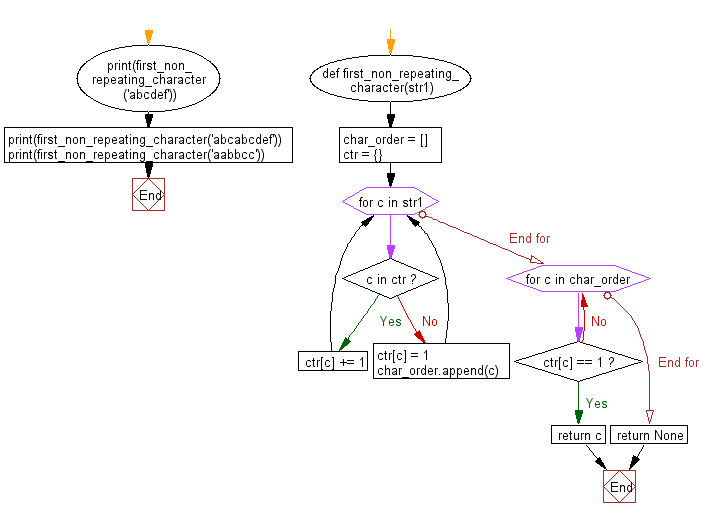Python: Find the first non-repeating character in given string
Find first non-repeating character.
Write a Python program to find the first non-repeating character in a given string.
Visual Presentation:
Sample Solution:
Python Code:
# Define a function 'first_non_repeating_character' that takes a string 'str1' as input.
def first_non_repeating_character(str1):
# Create an empty list 'char_order' to store the order of characters encountered.
char_order = []
# Create an empty dictionary 'ctr' to count the occurrences of each character.
ctr = {}
# Iterate through each character 'c' in the input string 'str1'.
for c in str1:
# Check if the character 'c' is already in the 'ctr' dictionary.
if c in ctr:
# If it is, increment the count for that character.
ctr[c] += 1
else:
# If it's not, add it to the 'ctr' dictionary and the 'char_order' list.
ctr[c] = 1
char_order.append(c)
# Iterate through the characters in 'char_order'.
for c in char_order:
# Check if the character 'c' has a count of 1 (non-repeating).
if ctr[c] == 1:
return c # Return the first non-repeating character.
return None # Return None if there are no non-repeating characters.
# Call the 'first_non_repeating_character' function with different input strings and print the results.
print(first_non_repeating_character('abcdef'))
print(first_non_repeating_character('abcabcdef'))
print(first_non_repeating_character('aabbcc'))
Sample Output:
a d None
Flowchart:

For more Practice: Solve these Related Problems:
- Write a Python program to find the first non-repeating character in a string using a dictionary to count character frequencies.
- Write a Python program to determine the first non-repeating character by iterating through the string and using an OrderedDict for preserving order.
- Write a Python program to implement a recursive function that identifies the first character that appears only once in the string.
- Write a Python program to find the index of the first non-repeating character and return both the character and its index.
Go to:
Previous: Write a Python program to split a string on the last occurrence of the delimiter.
Next:Write a Python program to print all permutations with given repetition number of characters of a given string
Python Code Editor:
What is the difficulty level of this exercise?
Test your Programming skills with w3resource's quiz.
